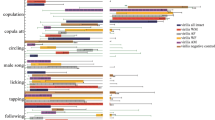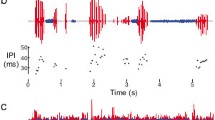Abstract
Males ofDrosophila littoralis vibrate their wings during courtship to deliver a “love song”. This consists of 25- to 50-ms-long pulses with a basic frequency of about 250–400 Hz, separated by 250- to 500-ms pauses. When recording the sounds of flies from several localities in Europe, we found that males of one strain from northern Finland displayed courtship sounds with an unusally low wing beat frequency (below 250 Hz). In a genetic analysis utilizing marker stocks, the anomalous frequency was found to be caused by genes on all major autosomes, the strongest factors being on the second chromosome. Interaction between genes on chromosome 2 and on the fused chromosome 3–4 was nonadditive. In low-frequency sounds, the number of cycles in the pulse (CN) was decreased, so that the length of the sound pulse (PL) remained more or less unchanged. We suggest that the genetically and physiologically most thoroughly controlled trait in the sound ofDrosophila littoralis is the length of the pulse.
Similar content being viewed by others
References
Aspi, J., Hoikkala, A., and Lumme, J. Interspecific variation in male courtship sound characteristics inDrosophila virilis group (in preparation).
Chang, H.-C., and Miller, D. D. (1978). Courtship and mating sounds in species of theDrosophila affinis subgroup.Evolution 32:540–550.
Cowling, D. E. (1980). The genetics ofDrosophila melanogaster courtship song—diallel analysis.Heredity 45:401–403.
Cowling, D. E., and Burnet, B. (1981). Courtship songs and genetic control of their acoustic characteristics in sibling species of theDrosophila melanogaster subgroup.Anim. Behav. 29:924–935.
Crossley, S. A. (1986). Courtship sounds and behaviour in the four species of theDrosophila bipectinata complex.Anim. Behav. 34:1146–1159.
Ewing, A. W. (1970). The evolution of courtship songs inDrosophila.Rev. Comp. Anim. 4:3–8.
Ewing, A. W. (1979). Complex courtship songs in theDrosophila funebris species group: Escape from an evolutionary bottleneck.Anim. Behav. 27:343–349.
Ewing, A. W., and Miyan, J. A. (1986). Sexual selection, sexual isolation and the evolution of song in theDrosophila repleta group of species.Anim. Behav. 34:421–429.
Hoikkala, A. (1985a). Genetic variation in the male courtship sound ofDrosophila littoralis.Behav. Genet. 15:135–142.
Hoikkala, A. (1985b). Evolution of the male courtship sound in the species of theDrosophila virilis group.Acta Univ. Ouluensis 175:1–40.
Hoikkala, A., and Lumme, J. (1984). Genetic control of the difference in male courtship sound betweenDrosophila virilis andD. lummei.Behav. Genet. 14:257–268.
Hoikkala, A., and Lumme, J. (1987). The genetic basis of evolution of the male courtship sounds in theDrosophila virilis group.Evolution 41:827–845.
Hoikkala, A., Lakovaara, S., and Romppainen, E. (1982). Mating behavior and male courtship sounds in theDrosophila virilis group. In Lakovaara, S. (ed.),Advances in Genetics, Development and Evolution of Drosophila, Plenum, New York, pp. 407–421.
Hoikkala, A., Hoy, R. R., and Kaneshiro, K. Y. (1989). High-frequency clicks of Hawaiian picturewingedDrosophila species.Anim. Behav. 37:927–934.
Hoy, R. R., Hoikkala, A., and Kaneshiro, K. (1988). Hawaiian courtship songs: evolutionary innovation in communication signals ofDrosophila.Science 240:217–219.
Ikeda, H., Takabatake, I., and Sawada, N. (1980). Variation in courtship sounds among three geographical strains ofDrosophila mercatorum.Behav. Genet. 4:361–375.
Kawanishi, M., and Watanabe, T. K. (1980). Genetic variation of courtship song ofDrosophila melanogaster andD. simulans.Jap. J. Genet. 55:235–240.
Kulkarni, S. J., and Hall, J. C. (1987). Behavioral and cytogenetic analysis of thecacophony courtship song mutant and interacting genetic variants inDrosophila melanogaster.Genetics 115:461–475.
Kulkarni, S. J., Steinlauf, A. F., and Hall, J. C. (1988). Thedissonance mutant of courtship song inDrosophila melanogaster: Isolation, behavior and cytogenetics.Genetics 118:267–285.
Kyriacou, C. P., and Hall, J. C. (1980). Circadian rhythm mutations inDrosophila melanogaster affect short-term fluctuations in the male's courtship song.Proc. Natl. Acad. Sci. 77(11):6729–6733.
Miller, D. D., Goldstein, R. B., and Patty, R. A. (1975). Semispecies ofDrosophila athabasca distinguishable by male courtship sounds.Evolution 29:531–544.
Snedecor, G. W., and Cochran, W. G. (1967).Statistical Methods, Iowa State University Press, Ames.
Sokal, R. R., and Rohlf, F. J. (1981).Biometry, Freeman, San Francisco, Calif.
von Schilcher, F. (1976). The behavior ofCacophony, a courtship song mutant inDrosophila melanogaster.Behav. Biol. 17:187–196.
von Schilcher, F. (1977). A mutation which changes courtship song inDrosophila melanogaster.Behav. Genet. 7:251–259.
Waldron, I. (1964). Courtship and sound production in two sympatric siblingDrosophila species.Science 144:191–193.
Author information
Authors and Affiliations
Rights and permissions
About this article
Cite this article
Hoikkala, A., Lumme, J. Inheritance of male courtship sound characteristics inDrosophila littoralis . Behav Genet 20, 423–435 (1990). https://doi.org/10.1007/BF01065567
Received:
Accepted:
Issue Date:
DOI: https://doi.org/10.1007/BF01065567




